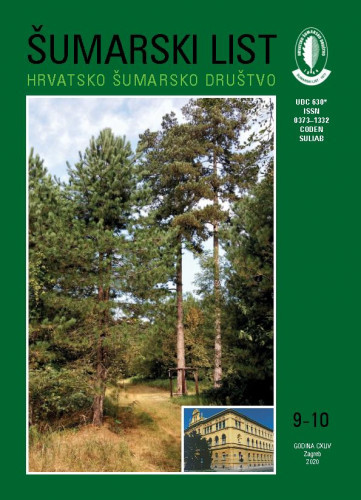Istraživanja su obavljena u nizinskom dijelu Varaždinske županije, u šumi posebne namjene „FOPER“, g. j. „Zelendvor odsjek 13c na oko 3 km udaljenosti od rijeke Drave na nadmorskoj visini od 190 m, u području gdje su sađene pretežito kulture smreke, borovca i bagrema iako je stanište pogodno za sadnju i uzgoj hrasta. S obzirom na promijenjene ekološke i klimatološke prilike osnovana je 2012. godine trajna pokusna ploha veličine 2,00 ha. Na plohi su posađene trogodišnje (2 + 1) sadnice hrasta lužnjaka (Quercus robur L.) i hrasta kitnjaka (Quercus petraea L.) i to na dva načina. Jedan dio u razmaku sadnje 3 x 3 m u polipropilenskim štitnicima. Drugi dio razmaka sadnje 2 x 2 m uobičajenim načinom (bez štitnika). Cijela je površina podijeljena na 24 pod plohe približnih površina. Na jednoj plohi nalazi se jedna vrsta drveća. Raspored vrsta je naizmjeničan od plohe do plohe. Upotrijebljen je randomizirani oblik metode, sa 4 bloka i 3 ponavljanja. Visine biljaka mjerene su 5 godina uzastopce za vrijeme mirovanja vegetacije. Prsni promjeri mjereni su na kraju promatranog razdoblja kada su biljke bile više od 1,30 m. Učešće i intenzitet pepelnice utvrđivan je tri godine tijekom ljetnih mjeseci. Cilj istraživanja je proučavanje rasta i razvoja sadnica hrasta lužnjaka i hrasta kitnjaka na prostoru gdje do sada nije bilo uobičajeno saditi navedene vrste, iako za to postoje ekološko gospodarski uvjeti. Istraživanja ukazuju kako je broj biljaka nakon 5 godina izmjere smanjen je za 14%. Kod hrasta lužnjaka smanjen je za 4 do 8%, a kod hrasta kitnjaka za 17 do 22%. Visine i prsni promjeri stabala u štitnicima značajno su veći bez obzira na vrstu drveća. Visine i prsni promjeri hrasta lužnjaka značajno su veće od hrasta kitnjaka. Nije utvrđena povezanost između visina stabala i prisutnosti pepelnice.; The research was carried out in the lowland region at a distance of about 3 km from the Drava River at an altitude of 190 m, in an area where mostly spruce, white pine and black locust are planted, although the habitat is suitable for planting and growing oak. Considering the changed ecological and climatological conditions, an experimental plot of 2.00 ha was established. Three-year-old (2 + 1) seedlings of pedunculate oak (Quercus robur) and sessile oak (Quercus petraea) were planted on the plot according to two different methods. The first group was planted at a distance of 3 x 3 m in polypropylene shelters. The second group was planted at a distance of 2 x 2 m in the regular way (without the shelters). The entire area was divided into 24 plots of approximately the same size. Each plot contained only one tree species. The arrangement of species alternated between the plots. A randomized block design was used, with 4 blocks and 3 replicates. Tree heights were measured for 5 consecutive years not during the growing season. Breast height diameters were measured at the end of the observed period. The impact and intensity of powdery mildew has been observed for three years during the summer months. The aim of the research is to study the growth and development of pedunculate oak and sessile oak seedlings in an area where these species were not commonly grown, although there are adequate ecological and economic conditions. After 5 years of measurement, the number of plants was reduced by 14%. In pedunculate oak the number of trees was reduced by 4 to 8%, and in sessile oak by 17 to 22%. The height and breast height diameters of the trees grown within the shelters were significantly higher regardless of the tree species. The height and breast height diameter of pedunculate oak trees was significantly larger than of sessile oak trees. No correlation was found between tree height and the presence of powdery mildew.
Sustavna praćenja konverzije sadnicama hrasta lužnjaka (Quercus robur L.) i kitnjaka (Quercus petraea L.) s obzirom na različit način sadnje = Systematic monitoring of the conversion of pedunculate oak (Quercus robur L.) and sessile oak (Quercus petraea L.) seedlings with regard to different planting methods / Miroslav Benko.
Sažetak

 Šumarski list : znanstveno-stručno i staleško glasilo Hrvatskoga šumarskog društva = journal of the Forestry Society of Croatia = Zeitschrift des Kroatischen Forstvereins = revue de la Societe forestiere Croate : 144, 9/10(2020) / glavni urednik Josip Margaletić.
Šumarski list : znanstveno-stručno i staleško glasilo Hrvatskoga šumarskog društva = journal of the Forestry Society of Croatia = Zeitschrift des Kroatischen Forstvereins = revue de la Societe forestiere Croate : 144, 9/10(2020) / glavni urednik Josip Margaletić.